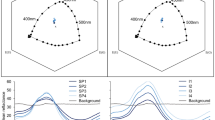Summary
Successive color contrast and color constancy were investigated with a behavioral training technique using pigment colors. In both experiments, single, freely flying bees were trained to land on one out of 9 differently colored test fields presented on a grey background.
-
1.
To investigate successive color contrast bees were exposed to a yellow or a blue adaptation color for several minutes and their choice behavior was tested immediately thereafter. Test fields less blue than the original training test field were chosen after adaptation to yellow, test fields of stronger blue after adaptation to blue (Fig. 2). This indicated that the ‘bee-subjective’ blue-green test fields must have appeared more blue after adaptation to yellow, and less blue after adaptation to blue. The effect lasted for about 2–3 min after adaptation durations of 1 and 2 min, and even longer after adaptation of 5 min measured for the yellow adaptation color (Fig. 3).
-
2.
To investigate color constancy bees were trained under a ‘white’ illumination, and tested under various yellow and blue illuminations. The choice behavior revealed (Fig. 4) that under almost all conditions, the training test field was clearly preferred. This indicated that the test fields appeared in almost unchanged hues, despite the fact that the light reflected by a given test field stimulated the three receptor types in very different ratios (Fig. 5). The mean choice behavior did not change significantly during the course of a test period under colored illumination (Fig. 6). In the following test period under ‘white’ illumination, aftereffects of chromatic adaptation were observed (Fig. 7).
Similar content being viewed by others
References
Baumann F, Mauro A (1973) Effect of hypoxia on the change in membrane conductance evoked by illumination in arthropod photoreceptors. Nature 244:146–148
Bertrand D, Fuortes G, Muri R (1979) Pigment transformation and electrical responses in retinula cells of drone,Apis mellifera. J Physiol 296:431–441
Cornsweet TN (1970) Visual perception. Academic Press, New York London
Daumer K (1956) Reizmetrische Untersuchung des Farbensehens der Bienen. Z Vergl Physiol 38:413–478
Erber J (1978) Response characteristics and aftereffects of multimodal neurons in the mushroom body area of the honey bee. Physiol Entomol 3:77–89
Goldsmith TH (1963) The course of light and dark adaptation in the compound eye of the honey-bee. Comp Biochem Physiol. 10:227–237
Graham CH (ed) (1966) Vision and visual perception. Wiley, New York
Hamdorf K, Schwemer J (1975) Photoregeneration and the adaptation process in insect photoreceptors. In: Snyder AW, Menzel R (eds) Photoreceptor optics. Springer, Berlin Heidelberg New York, pp 263–289
Helverson O von (1972) Zur spektralen Unterschiedsempfindlichkeit der Biene. J Comp Physiol 80:439–472
Henderson ST (1977) Daylight and its spectrum, 2nd ed. Hilger, Bristol
Henderson ST, Hodgkiss D (1963) The spectral distribution of daylight. Br J Appl Phys 14:125–131
Laughlin SB (1975) Receptor and interneuron light-adaptation in the dragonfly visual system. Z Naturforsch C 30:306–308
Laughlin SB, Hardie RC (1978) Common strategies for light adaptation in the peripheral visual systems of fly and dragonfly. J Comp Physiol 128:319–340
Mazokhin-Porshnjakov GA (1966) Recognition of colored objects by insects. In: Bernhard CG (ed) The functional organization of the compound eye. Pergamon Press, Oxford
Moericke V (1950) Über das Farbensehen der Pfirsichblattlaus (Myzodes persicae Sulz). Z Tierpsychol 7:265–274
Neumeyer C (1980) Simultaneous color contrast in the honeybee. J Comp Physiol 139:165–176
Schwemer J, Paulsen R (1973) Three visual pigments inDeilephila elpenor (Lepidoptera, Sphingidae). J Comp Physiol 86:215–229
Stavenga DG, Kuiper JW (1977) Insect pupil mechanisms. I. On the pigment migration in the retinula cells of Hymenoptera (Suborder Apocrita). J Comp Physiol 113:55–72
Wyszecki G, Stiles WS (1967) Color science. Wiley, New York London Sidney
Author information
Authors and Affiliations
Additional information
Supported by the Deutsche Forschungsgemeinschaft (Ne 215/1, and SFB 70/A6 (Dr. L. Spillmann))
I thank Mr. N. Beckhaus for correcting the English manuscript, and Prof. Dr. C. von Campenhausen for critically reading the text.
Rights and permissions
About this article
Cite this article
Neumeyer, C. Chromatic adaptation in the honeybee: Successive color contrast and color constancy. J. Comp. Physiol. 144, 543–553 (1981). https://doi.org/10.1007/BF01326839
Accepted:
Issue Date:
DOI: https://doi.org/10.1007/BF01326839



